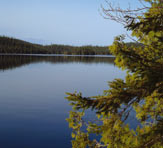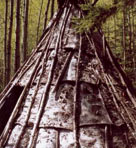  |
|
| |
Youth |
| |
|
| |
Go to: |
| |
Aboriginal youth career paths general |
| |
Aboriginal youth and the land |
| |
Aboriginal education in general |
| |
|
| |
|
| |
Aboriginal youth career paths general |
| |
Consulbec. 2002. Connecting the dots: A study of perceptions, expectations, and career choices of Aboriginal youth. Aboriginal Human Resources Development Council of Canada. March 2002. |
| |
This study reports findings from surveying 433 Aboriginal youth. Forestry was of interest as a career to only 12% of the youth, and it was ranked 32nd out 0f 39 careers under consideration. |
| |
Native Access in Engineering Programme website |
| |
|
| |
|
| |
Aboriginal youth and the land |
| |
February 10, 2005 -
Manitoba minister recognizes importance of trapping for Aboriginal youth |
| |
Thomas, J. 2006. Forest high: School forestry program sparks interest. Working Forest 10:8. |
| |
|
| |
|
| |
Aboriginal education in general |
| |
Note that many of the references provided in the traditional knowledge bibliography on this website are also very relevant to general issues of Aboriginal education. |
| |
Aikenhead, G. 2001. Integrating western and Aboriginal sciences: Cross-cultural science teaching. Research in Science Education 31: 337-355.
|
| |
The article addresses issues of social power and privilege experienced by Aboriginal students in science classrooms. First, I present a rationale for a cross-cultural science education dedicated to all students making personal meaning out of their science classrooms. Then I describe a practical research and development project, "Rekindling Traditions: Cross-Cultural Science & Technology Units," that modestly illustrates cross-cultural science teachng for years 6-11, in which Western and Aboriginal sciences are integrated. This integration is discussed in terms of the "Rekindling Traditions" units, including the assessment of students." |
| |
Department of Indian and Northern Development and Human Reources Development Canada. 1999. Balancing choices: Opportunities in science and technology for Aboriginal People. Conference proceedings. April 1999. Winnipeg. |
| |
John, G. (2001). Trodding the circle from Indian community to university research and back. In Science and Native American Communities: Legacies of Pain, Visions of Promise, K. James, pp 63-68. University of Nebraska Press. |
| |
Kimmerer, R. W. 2002. Weaving traditional ecological knowledge into biological education: A call to action." Bioscience 52(5): 432. |
| |
Mendelson, M. 2006. Aboriginal Peoples and postsecondary education in Canada. Ottawa, ON: Caledon Institute of Social Policy. |
| |
Stephens, S. (2000). Handbook for Culturally Responsive Science Curriculum. Alaska Native Knowledge Network. A. S. C. a. t. A. R. S. Initiative, Alaska Science Consortium. 2004: Report.
|
| |
“The culturally responsive science curriculum attempts to integrate Native and Western Knowledge systems around science topics with goals of enhancing the cultural well-being and the science skills and knowledge of students. It assumes that students come to school with a whole set of beliefs, skills and understandings formed from their experiences in the world, and that the role of the school is not to ignore or replace prior understanding, but to recognize and make connections to that understanding. It assumes that there are multiple ways of viewing, structuring, and transmitting knowledge about the world—each with its own insights and limitations. It thus values both the rich knowledge of Native Alaskan cultures and of Western science and regards them as complementary to one another in mutually beneficial ways.” (Introduction to Handbook) |
| |
Turner, R. 2006. My land ethic. The Forestry Chronicle 82(2): 124-125.
|
| |
Turner reflects on his own cultural grounding in traditional community culture and values, and how his decision to enter a professional forestry program may or may not compromise those concerns. |
| |
|
| |
|
| |
|
| |
|
| |
|
| |
|
| |
|
| |
|
| |
|
| |
|
| |
|
| |
|
| |
|
| |
|
| |
|
| |
|
| |
|
| |
|
| |
|
| |
|
| |
|


